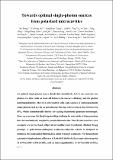Files in this item
Towards optimal single-photon sources from polarized microcavities
Item metadata
| dc.contributor.author | Wang, Hui | |
| dc.contributor.author | He, Yu-Ming | |
| dc.contributor.author | Chung, T.-H. | |
| dc.contributor.author | Hu, Hai | |
| dc.contributor.author | Yu, Ying | |
| dc.contributor.author | Chen, Si | |
| dc.contributor.author | Ding, Xing | |
| dc.contributor.author | Chen, M.-C. | |
| dc.contributor.author | Qin, Jian | |
| dc.contributor.author | Yang, Xiaoxia | |
| dc.contributor.author | Liu, Run-Ze | |
| dc.contributor.author | Duan, Z.-C. | |
| dc.contributor.author | Li, J.-P. | |
| dc.contributor.author | Gerhardt, S. | |
| dc.contributor.author | Winkler, K. | |
| dc.contributor.author | Jurkat, J. | |
| dc.contributor.author | Wang, Lin-Jun | |
| dc.contributor.author | Gregersen, Niels | |
| dc.contributor.author | Huo, Yong-Heng | |
| dc.contributor.author | Dai, Qing | |
| dc.contributor.author | Yu, Siyuan | |
| dc.contributor.author | Höfling, Sven | |
| dc.contributor.author | Lu, Chao-Yang | |
| dc.contributor.author | Pan, Jian-Wei | |
| dc.date.accessioned | 2020-02-05T00:35:58Z | |
| dc.date.available | 2020-02-05T00:35:58Z | |
| dc.date.issued | 2019-08-05 | |
| dc.identifier | 259361588 | |
| dc.identifier | 6fdc92f1-bae7-4397-9e87-cd4aaf9fd951 | |
| dc.identifier | 85070334081 | |
| dc.identifier | 000493317900012 | |
| dc.identifier.citation | Wang , H , He , Y-M , Chung , T-H , Hu , H , Yu , Y , Chen , S , Ding , X , Chen , M-C , Qin , J , Yang , X , Liu , R-Z , Duan , Z-C , Li , J-P , Gerhardt , S , Winkler , K , Jurkat , J , Wang , L-J , Gregersen , N , Huo , Y-H , Dai , Q , Yu , S , Höfling , S , Lu , C-Y & Pan , J-W 2019 , ' Towards optimal single-photon sources from polarized microcavities ' , Nature Photonics . https://doi.org/10.1038/s41566-019-0494-3 | en |
| dc.identifier.issn | 1749-4885 | |
| dc.identifier.uri | https://hdl.handle.net/10023/19410 | |
| dc.description.abstract | An optimal single-photon source should deterministically deliver one, and only one, photon at a time, with no trade-off between the source’s efficiency and the photon indistinguishability. However, all reported solid-state sources of indistinguishable single photons had to rely on polarization filtering, which reduced the efficiency by 50%, fundamentally limiting the scaling of photonic quantum technologies. Here, we overcome this long-standing challenge by coherently driving quantum dots deterministically coupled to polarization-selective Purcell microcavities. We present two examples: narrowband, elliptical micropillars and broadband, elliptical Bragg gratings. A polarization-orthogonal excitation–collection scheme is designed to minimize the polarization filtering loss under resonant excitation. We demonstrate a polarized single-photon efficiency of 0.60 ± 0.02 (0.56 ± 0.02), a single-photon purity of 0.975 ± 0.005 (0.991 ± 0.003) and an indistinguishability of 0.975 ± 0.006 (0.951 ± 0.005) for the micropillar (Bragg grating) device. Our work provides promising solutions for truly optimal single-photon sources combining near-unity indistinguishability and near-unity system efficiency simultaneously. | |
| dc.format.extent | 6 | |
| dc.format.extent | 915044 | |
| dc.language.iso | eng | |
| dc.relation.ispartof | Nature Photonics | en |
| dc.subject | QC Physics | en |
| dc.subject | TK Electrical engineering. Electronics Nuclear engineering | en |
| dc.subject | NDAS | en |
| dc.subject.lcc | QC | en |
| dc.subject.lcc | TK | en |
| dc.title | Towards optimal single-photon sources from polarized microcavities | en |
| dc.type | Journal article | en |
| dc.contributor.institution | University of St Andrews. Condensed Matter Physics | en |
| dc.contributor.institution | University of St Andrews. School of Physics and Astronomy | en |
| dc.identifier.doi | https://doi.org/10.1038/s41566-019-0494-3 | |
| dc.description.status | Peer reviewed | en |
| dc.date.embargoedUntil | 2020-02-05 |
This item appears in the following Collection(s)
Items in the St Andrews Research Repository are protected by copyright, with all rights reserved, unless otherwise indicated.

